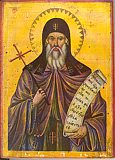

| Previous day | Next day |
| Old Style
January 15
|
Tuesday |
New Style
January 28
|
| 33rd Week after Pentecost. Tone 7. | No fast.
|
![]() St. Paul of Thebes, Egypt (341).
St. Paul of Thebes, Egypt (341). ![]() St. John Calabytes (“Hut-dweller”) of Constantinople, monks (5th c.).
St. John Calabytes (“Hut-dweller”) of Constantinople, monks (5th c.).
Monk-martyr Pansophius of Alexandria (249-251). St. Prochorus, abbot, in the Vranski Desert on the river Pchinja in Bulgaria (10th c.). St. Gabriel, founder of Lesnovo Monastery, Serbia-Bulgaria (11th c.). St. Nectarius, archbishop of Tobolsk (1667).
St. Maximus, bishop of Nola (ca. 250). St. Salome of Udjarma, and St. Perozhavra of Sivnia, Georgia (4th c.). St. Ita of Killeedy, hermitess (570). St. Maurus, disciple of St. Benedict of Nursia (584).
Thoughts for Each Day of the Year
According to the Daily Church Readings from the Word of God
By St. Theophan the Recluse

Tuesday. [James 3:1–10; Mark 11:11–23]
The Lord took away His blessing from the fig tree which was rich with leaves but had no fruit, and it dried up. This is a lesson in action. The fig tree represents people who in appearance are proper, but in essence are not worthy of approval. Who are these people? They are those who eloquently discourse about the faith, but do not have that faith—they hold the objects of faith in the intellect only. They are those whose outward behaviour is proper but their feelings and dispositions are very improper, and they manifest proper works only to hide their impropriety from people; whenever possible, they do not do these works. For example, such a person gives alms when someone asks of him in front of people, but ask him in private and he will berate you. He goes to church to pray to God, prays in sight of everyone, and prays at home as well, so as to not bring shame upon himself before his household. But as soon as he is alone, he does not even make the sign of the cross over his brow. He does not have any idea about turning to God with the mind and heart. Let us pray that God will not allow us to be as these. For then we will not escape the judgement pronounced over the fig tree.
Articles
 Venerable Paul of ThebesSettling into a mountain cave, Saint Paul dwelt there for ninety-one years, praying incessantly to God both day and night. |
 Venerable Pansophius of Alexandria, the MartyrThe Monk Martyr Pansophius, was a son of the Alexandrian proconsul Nilus. |
 Saints Salome of Ujarma and Perozhavra of SivniaSaints Salome of Ujarma and Perozhavra of Sivnia were the helpers and closest companions of Saint Nino, Enlightener of Georgia. |






